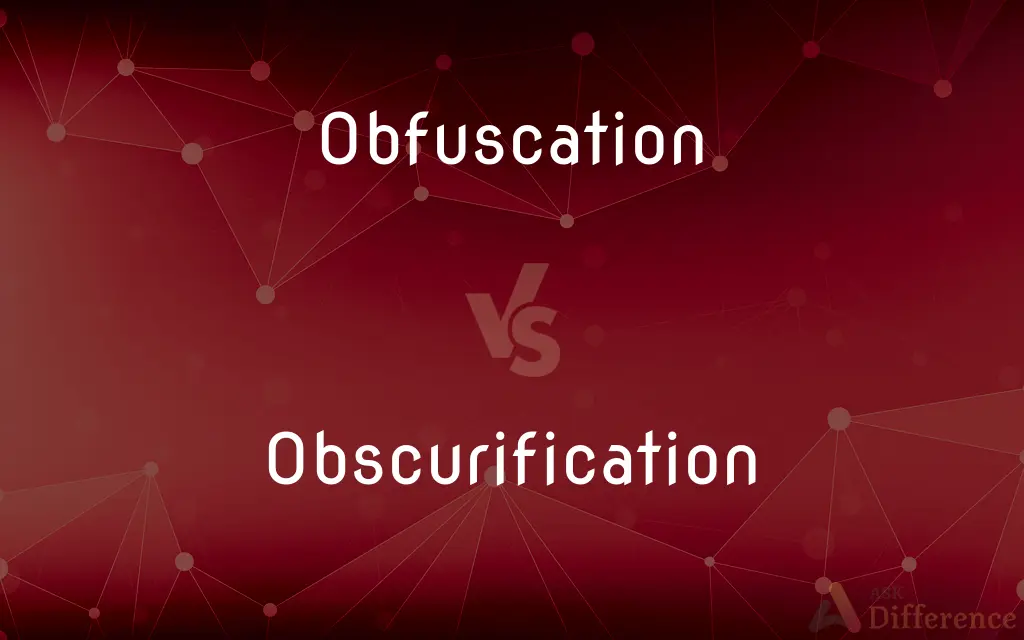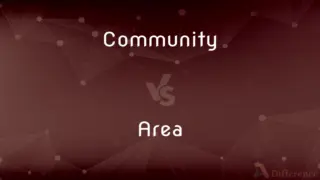Obfuscation vs. Obscurification — What's the Difference?
By Maham Liaqat & Urooj Arif — Updated on April 15, 2024
Obfuscation involves deliberate complexity to obscure meaning, often in tech contexts; obscurification, less common, refers to making something dark or unclear, generally in literature.

Difference Between Obfuscation and Obscurification
Table of Contents
ADVERTISEMENT
Key Differences
Obfuscation is primarily used in technical and security contexts to intentionally make information difficult to understand, thereby enhancing privacy or security. On the other hand, obscurification, although similar in effect, is less frequently used and often appears in literary or artistic discussions to describe the act of making something obscure or unclear, without the connotations of intent or technique.
In programming, obfuscation is a method to protect source code by making it confusing and less readable to prevent unauthorized access or understanding. Whereas obscurification may be employed in literature to create an atmosphere of mystery or ambiguity, enhancing the thematic or emotional depth of a text.
Obfuscation is strategically implemented in data protection, where data is masked to prevent unauthorized use while maintaining its usability for legitimate purposes. In contrast, obscurification could be used in visual arts to subtly alter perceptions or evoke curiosity without a direct focus on security or privacy.
Techniques of obfuscation include using complex algorithms, inserting misleading information, or encoding data in ways that require specific knowledge or tools to decode. On the other hand, obscurification might involve using metaphorical language, vague descriptions, or shadowy imagery to conceal true meanings or themes.
The goal of obfuscation in cybersecurity is to deter hackers by making systems harder to penetrate or manipulate. Conversely, obscurification in artistic contexts aims to engage viewers or readers more deeply, prompting them to explore underlying messages or themes through interpretative challenges.
ADVERTISEMENT
Comparison Chart
Primary Context
Technology, cybersecurity
Literature, art
Purpose
Protect privacy, secure information
Enhance artistic or thematic depth
Techniques
Code complexity, misleading info, encoding
Metaphorical language, vague imagery
Effect
Makes information hard to access or understand
Makes meaning vague or interpretable
Frequency of Use
Common in tech and legal fields
Less common, more prevalent in creative fields
Compare with Definitions
Obfuscation
In software, a way to prevent reverse engineering.
Obfuscation is crucial for software that contains sensitive algorithms.
Obscurification
Making something dark or unclear, especially in wording.
The poet's use of obscurification gave his work a mysterious quality.
Obfuscation
Intentional act of making something confusing or difficult to understand.
The lawyer used legal jargon to obfuscate the contract terms.
Obscurification
Artistic strategy to engage and provoke thought.
The artist's obscurification of traditional forms challenged viewers.
Obfuscation
A method to protect data by altering its appearance.
Obfuscation techniques can prevent data breaches.
Obscurification
Used to create ambiguity or confusion intentionally.
Her narrative technique involved obscurification of key plot points.
Obfuscation
Technique in cryptography to mask data.
He applied obfuscation to secure the transmitted messages.
Obscurification
Literary device to enhance depth and intrigue.
Obscurification in the novel prevented readers from anticipating the climax.
Obfuscation
Process of hiding the true intent or functionality.
Politicians often obfuscate their motives.
Obscurification
Method to veil the true meaning in art.
Obscurification was used to subtly criticize societal norms.
Obfuscation
Obfuscation is the obscuring of the intended meaning of communication by making the message difficult to understand, usually with confusing and ambiguous language. The obfuscation might be either unintentional or intentional (although intent usually is connoted), and is accomplished with circumlocution (talking around the subject), the use of jargon (technical language of a profession), and the use of an argot (ingroup language) of limited communicative value to outsiders.In expository writing, unintentional obfuscation usually occurs in draft documents, at the beginning of composition; such obfuscation is illuminated with critical thinking and editorial revision, either by the writer or by an editor.
Obscurification
The act of making something obscure, or (in computing) obfuscating source code etc.
Obfuscation
To make so confused or opaque as to be difficult to perceive or understand
"A great effort was made ... to obscure or obfuscate the truth" (Robert Conquest).
Obfuscation
To render indistinct or dim; darken
The fog obfuscated the shore.
Obfuscation
(uncountable) The act or process of obfuscating, or obscuring the perception of something; the concept of concealing the meaning of a communication by making it more confusing and harder to interpret.
Obfuscation
The alteration of computer code to preserve its behavior while concealing its structure and intent.
You need to turn on obfuscation for these classes.
Obfuscation
(uncountable) Confusion, bewilderment, or a baffled state resulting from something obfuscated, or made more opaque and muddled with the intent to obscure information.
Obfuscation
(countable) A single instance of intentionally obscuring the meaning of something to make it more difficult to grasp.
During the debate, the candidate sighed at his opponent's obfuscations.
Obfuscation
The act of darkening or bewildering; the state of being darkened.
Obfuscation
Confusion resulting from failure to understand
Obfuscation
The activity of obscuring people's understanding, leaving them baffled or bewildered
Obfuscation
Darkening or obscuring the sight of something
Common Curiosities
Is obscurification a common technique in modern art?
Yes, it is used to engage audiences and provoke deeper interpretation.
What is the main purpose of obfuscation?
To enhance security or privacy by making information confusing and hard to understand.
Can obfuscation be beneficial in everyday communication?
Typically, it is not beneficial as it complicates understanding, unless used for privacy.
Does obscurification play a role in digital media?
Yes, particularly in interactive art or digital narratives to enhance user engagement.
How does obscurification affect the reader's experience in literature?
It can either enrich the experience by adding depth or frustrate by complicating clarity.
How do artists justify the use of obscurification?
As a means to enhance artistic expression and engage audiences more deeply.
What is a simple example of obfuscation in everyday life?
Using complex or technical language unnecessarily to obscure simple facts.
What are common techniques of obfuscation in cybersecurity?
Including misleading information, complex encoding, and algorithmic transformations.
How is obscurification typically used in literature?
To create mystery or ambiguity, enhancing the emotional or thematic depth.
Are there ethical concerns associated with obfuscation?
Yes, especially if used to mislead or deceive stakeholders or consumers.
What is the difference between obfuscation and encryption?
Obfuscation disguises information's appearance, whereas encryption secures it cryptographically.
What industries benefit most from obfuscation?
Technology and cybersecurity industries, where information security is paramount.
Can obscurification enhance a film's narrative?
Yes, by adding layers of meaning or unresolved mysteries that enrich the viewing experience.
Is there a risk of overusing obfuscation in communication?
Yes, overuse can lead to misunderstandings and decreased effectiveness in communication.
Can obscurification be used effectively in academic writing?
Generally, clarity is preferred in academic writing, making obscurification less suitable.
Share Your Discovery

Previous Comparison
Haunch vs. Loin
Next Comparison
Community vs. AreaAuthor Spotlight
Written by
Maham LiaqatCo-written by
Urooj ArifUrooj is a skilled content writer at Ask Difference, known for her exceptional ability to simplify complex topics into engaging and informative content. With a passion for research and a flair for clear, concise writing, she consistently delivers articles that resonate with our diverse audience.















































